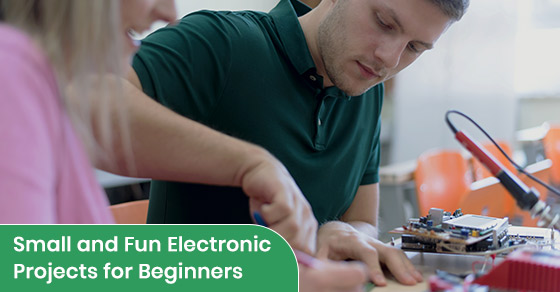Small and Fun Electronic Projects for Beginners
Many would-be engineers enjoy tinkering with various electronic components in order to fabricate DIY projects that they can proudly call their own. Many of their efforts will prove fruitful, thanks to the recent streamlining of various projects, and the relatively low cost of many components on the open market.
Here, we will discuss some small and fun electronic projects that beginners can get into with minimal effort and know-how.
Creating a Mini-Charger
In the past, many people would need to spend large sums of money to charge their USB-based devices while travelling from destination to destination. Today, however, things have changed significantly. While many people opt for portable chargers that they can purchase for a small amount on eBay or Amazon, another option is to make one yourself.
You can build your very own battery-powered USB charger using a small tin, such as an Altoids tin. To create the device, you will need 2 AA batteries and some charge circuitry, as well as an Altoids tin — or something of comparable size — to house the components.
You can also use rechargeable batteries instead of the 2 AA batteries if you wish. You can even upgrade to either D or C cells to create a mega battery pack. Virtually any device, including smartphones, cameras, and music players, can be charged via this homemade USB charger. For full details/specifications, please consult this guide.
USB Light
Another fun and exciting project involves using a supercapacitor to power a tiny LED. To do so, you will first need to charge the supercapacitor using a USB unit. The components that you will need to build your supercapacitor USB light are an LED, a supercapacitor, and a USB plug.
We would suggest that you use it as an emergency light in the event of a power failure in your home. For a full step-by-step guide on how to build a reliable supercapacitor USB light for a few dollars, take a look at this guide
Stereo Mixer
Audiophiles who also enjoy do-it-yourself projects may get some enjoyment out of making a stereo mixer using an Altoids tin. You will be able to enjoy multiple audio inputs via a stereo, such as a car stereo.
This is a fairly simple project that many beginners will enjoy working on and only requires a few components to complete. For a full guide on how to build a car stereo mixer using an Altoids tin and a few other components, please consult this guide.
Universal Remote
If you have to use more than one remote to enjoy your entertainment hub at home, then you may be thinking about making things easier on yourself via a universal remote. However, while you can pick up a universal remote at your local retailer, or order one online for that matter, it may be more rewarding to make one yourself.
You can make your own remote to turn many television sets on and off with ease. The device will also scan for several different frequencies by itself, and th
For a full guide on how to build your very own universal remote in a few hours, take a look at this guide.
LED-Based Throwies
For those who have never tackled a DIY project before, this one comes highly recommended, as anyone can do it with the right materials. Here, you will be making LED throwies, and you can decorate your entire house for the holidays or kick spring off right by using thousands of these luminous beauties. The LED throwies look like Skittles that have been set alright, and you will need to tape the LEDs to a watch battery to complete the job.
Flashlight Chapstick
If you want to feel like a stealthy spy, then why not build a makeshift flashlight that fits in a chapstick container? For just a few dollars, you can make an LED flashlight that can be housed comfortably in a chapstick container with just a little know-how and patience.
For the full guide on how to do so, click here.
Take the Next Step
While the aforementioned projects are very simple to take-on, this one will take a little bit more know-how, but we would still consider it to be a relatively small and easy project for most people.
Here, we will be making a persistence-of-vision toy that can be enjoyed by people of all ages.
It also serves as a superb introduction to newcomers who want to learn the basics of programming a microcontroller, as well as the fundamentals of assembling kits and soldering.
In fact, this website has all the required code that you will need in order to program the microcontroller, so you can simply download it when you have the time.
You will only need to modify a mere fraction of the code to program your personalized message into the system. This means newbies who want to start with an easy project should look no further than this fun and exciting persistence-of-vision project.
There is a myriad of different projects that neophytes can tackle with just a little bit of money, patience, and gumption, with more advanced projects available for those who are prepared to take things to the next level.
For more small and fun electronic projects for beginners, call Circuits Central at 888-821-7746 or contact us here.

